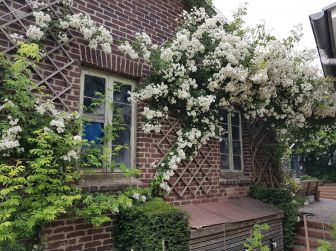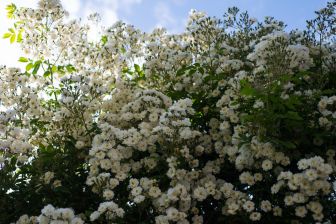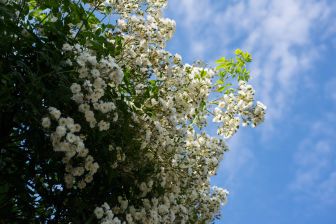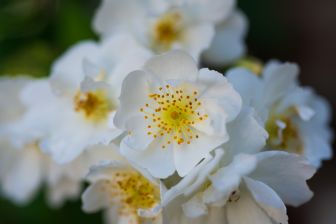The Rose Rambling Rector
The tufted, rambling pastor
It should actually be called Mille Fleur, this rose. With a similar sound to the French word Mille-feuille for a cake made only of puff pastry.
The history of this rose lies in the dark, it leads back among other things to the English gardener Thomas "Tom" Smith, and has something remotely to do with the Silesian-Prussian jurist Max Ernst Wichura, who was born in Neisse in 1817. The story of this rose takes us to the Irish town of An tIúr (the yew tree) , whose history dates back to 1144. Despite its name, the story of this rose has nothing to do with a school - probably - but probably with a parish garden in eastern Ireland.
We are talking about the rose Rambling Rector and it has made us overjoyed in our garden for seven years. Only one day a year do I curse it because then I have to prune it. It has the worst thorns of all the roses in our garden. Nevertheless, I love this rose with all my heart, because its blossoming at the beginning of June is a great, actually too great, gift of nature to the heart of the beholder. I try to appreciate it in many photos, but you have to experience it yourself. Early in the morning, when you leave the house with a fresh cup of coffee, the whole air is filled with their incomparable and delicate fresh scent, emitted by the thousands and thousands of flowers. For a period of one to three weeks, it usually gives us a buzzing white cloud in early to mid-June. Hundreds of bees that have strengthened themselves beforehand in our sage fly to the blossoms. It hums and buzzes underneath - it is the sign that spring is finally over - summer is here.
Rambling Rector
A climbing wonder
The Rose Rambling Rector is a so-called rambler rose. This name comes from the English word ramble - to wander about. (Note: In this respect it suits me perfectly.) Rambler roses have not been around that long, their breeding began at the beginning of the 19th century. By crossing the Chinese tufted rose Rosa multiflora and Rosa wichuraiana, a new group of sometimes extremely strong climbing roses was created. Already in the second year, rambler roses develop shoots up to 6 m long, on which the flower umbels appear the next year. They can climb up to 10 m high and in early summer their clusters of small wild rose-like flowers unfold a lavish splendour of blossoms. There are varieties of varying vigour and most, with the exception of the remontant rose New Dawn, only flower once a year. If you want to buy a rambler rose, you should have enough space available. Rambler roses are particularly well suited for planting on large house walls (with regular pruning) and old trees, where they spread independently right up to the crown. The rose is very hardy to pests and leaf diseases, and the foliage is a healthy green throughout.
We caught the white climbing rose virus in the beautiful garden of Vita Sackville-West. However, in the white garden at Sissinghurst it is a Rosa R. mulliganii that is there, elegantly designed by her husband Harold Nicolson. As a climbing aid, I carpentered over-leafed rose trellises from pitch pine in April 2015, which are screwed to our renovated brick façade. What you should pay attention to, at least at the beginning, is that the shoots do not grow behind the trellis. Over the years, the shoots grow up to wrist-thick and pull every plug out of the wall. (I have seen it happen). In the beginning we planted a rose Rambling Rector and a rose Seagull. They are very similar, in many forums it is even suspected that they are the same rose under different names.
Max Ernst Wichura
The history of Rosa wichuraiana
Max Ernst Wichura
Max Ernst Wichura (* 27 January 1817 in Neisse; † 24/25 February 1866 in Berlin) was a Silesian-Prussian jurist, government councillor and botanical traveller. He studied law in Breslau and Bonn from 1836-39, was a city judge in Breslau from 1851-1857, then changed to administration and was appointed government councillor in Breslau in 1859. He undertook several botanical journeys. At the suggestion of the Academy of Sciences, he, together with the zoologist Eduard von Martens, the gardener Otto Schottmüller , staff physician Carl Friedel and Ferdinand von Richthofen, accompanied the Prussian expedition on the SMS Thetis (1855) to East Asia as botanist from autumn 1859. They visited Madeira, Rio de Janeiro, Singapore, Manila and various coasts of the Chinese and Japanese empires. After his return in the summer of 1863, he was granted leave at the end of 1865 to work on his plant collection in Berlin. He succumbed to carbon monoxide poisoning in the process.
Quelle: Wikipedia
Without the Rosa wichuraiana there would be no rambler roses. Rosa wichuraiana came to Europe through the Silesian-Prussian jurist Max Ernst Wichura. He collected it during a mission on behalf of the Academy of Sciences - together with other botanists and geographers on board the former British sailing frigate MS Thetis - in Japan for the botanical garden in Berlin. The species epithet (a species-specific name appended after the genus) honours the jurist for this, but the variety was already described in 1871 under the name Rosa lucieae by Adrien René Franchet and Alphonse Trémeau de Rochbrune. With their epithet they honoured Madame Lucie Savatier. The rose is originally found in Korea, the Philippines, the Japanese islands and in some provinces of China.
Thomas Smith
The Daisy Hill Nursery in Newry, Nordirland
Iúr Cinn Trá,
"the yew tree at the end of the bank". The old Irish name alludes to a legend according to which St. Patrick of Ireland planted a yew tree on the edge of the Clanrye River in the fifth century. Later, this sonorous name became the English name Newry for this town on the banks of the Newry River, in County Down, now the district of Newry, Mourne and Down. Here, from 1887 to 1990, for over 100 years, was one of the most important nurseries in Northern Ireland and Europe.
The beginnings
In 1870 a gardener answered an advertisement for a small nursery, still owned at that time by Mr. J. A. Daly. This was the day that was to make Daisy Hill Nursery (Nursery for tree nursery) one of the most important in Ireland. This nurseryman and later grower was Thomas "Tom" Smith, the son of a Birmingham gardener, who began his career as a garden boy of thirteen in Mr Gladstone's small garden in Edgbaston, Birmingham. At fifteen he moved to the garden of Witley Court, the seat of the Earl of Dudley. The stately home had a large garden designed by William Nesfield. The estate, with one of the largest fountains in Europe, burnt down completely in 1937 and is now owned by English Heritage.
Founded in 1887
After his time there, Thomas Smith joined the gardener and grower (nurseryman) Hugh Low & Co in Clapton. He then became foreman at Veitch & Son Ltd in Chelsea, where he remained for three years. He made a name for himself with exhibition plantings for the International Exhibition in Paris (with azaleas) and in Hamburg (with geraniums) for his new employer John Smith. Until 1887 he worked for John Smith, Dulwich in the small nursery at Newry until he bought two small 2 acre meadows covered with daisies. The soil was ideal for his plans, loamy, slightly acidic. Under his skilful hands, the nursery expanded rapidly and he made a name for himself internationally. He bought more land until he had an area of 60 hectares. At the best of times, the business employed 80 men and women. This was the time when the nursery held the most prestigious stock of plants perhaps in all of Europe. New plants were constantly being imported, especially from Asia, and the nursery held 5000 different plants, of which over 600 were roses. Daisy Hill Nursery was responsible for over 200 new varieties, including such melodious broom varieties (Cytisus albus) as Firefly, Dragonfly, Mayfly, Moonlight and Daisy Hill.
The nursery became more famous, Thomas Smith was awarded several times for his work, as the first Irish breeder with the Victoria Medal of Honour. It was known beyond the borders of Ireland and Great Britain to North America and Japan. From 1897 the nursery published its own catalogues.
The children and the difficult time after World War I
Thomas Smith died in 1919 at the age of 79, active to the end of his fulfilled life. He left behind 2 sons and 6 daughters. His sons continued their father's work, but with the end of the First World War they had to cope with many problems, because the Dutch breeding farms massively pressed the English market. Under the sons' hands, the character of the nursery changed, benches were put up, everyone could go out on the grounds for their pleasure. Many gardeners subsequently continued the nursery until its end in 1990.
Why did the nursery have to close? For similar reasons as many traditional nurseries here ceased to operate: They cannot compete with DIY stores and garden centres and the thoughtlessness and ignorance of customers. Many people want to buy large flowering plants, which is what the garden centres specialise in, but they only offer one type of sage or geranium, of which there are dozens if not hundreds. The main thing is that the plant is fully flowered and large. In Wuppertal there is the traditional Arends Maubach nursery, founded by Georg Arends in 1888, but this nursery has also had to change a lot, because unfortunately many people are not prepared to pay 2 euros more for a locally grown plant, which is then a third smaller.
In Willich there is the traditional perennial nursery Diana and Johan van Diemen, which I can highly recommend and which is always worth a visit. There are good, very good reasons to buy from nurseries. Often they have varieties in cultivation that are rare and special, that differ from the 0815 goods of the large garden centres. Usually the advice is excellent and the van Diemen nursery has a very nice show garden, while in Wuppertal Ronsorf Arends Maubach has a very nice show garden and a very nice café.
Finis: What does all this have to do with the Rambling Rector?
The rose of a small vicarage
I found out that the rose Rambling Rector was first mentioned in the Daisy Hill Nursery rose catalogue of 1912. Thomas Smith is said to have discovered the rose in the garden of a small vicarage garden. And the name of a vicar can also be called Rector in English. At least this is what the Irish Garden Plant Society writes about the rose Rambling Rector on its website. The English horticulturist and rose breeder Graham Stuart Thomas is quoted about this rose: "a very old variety with large clusters of fragrant, semi-double flowers, which are cream at first and then open white with yellow centres".
The time in which this rose blooms is short. It is a question of enjoying every moment. In spring after pruning, when my hands are full of prickles, I will remember these wonderful moments and this breathtaking sight.

In 2020, after the Seagull rose had died, we planted a second Rambling Rector. By the end of the year it was about 1 m 50 tall.

The same rose as in the first picture above left one year later, in 2021. It is now almost three metres high and is about to flower at the beginning of June.

That was already very opulent in 2019. Depending on how you tie the strong shoots down, you can force a strong flower set.
tl, dr;
The rose Rambling Rector is one of the stars of our garden. It separates the courtyard from the garden. It only blooms once a year, but then with thousands of flowers. It has an exciting origin story.














Comments (0)